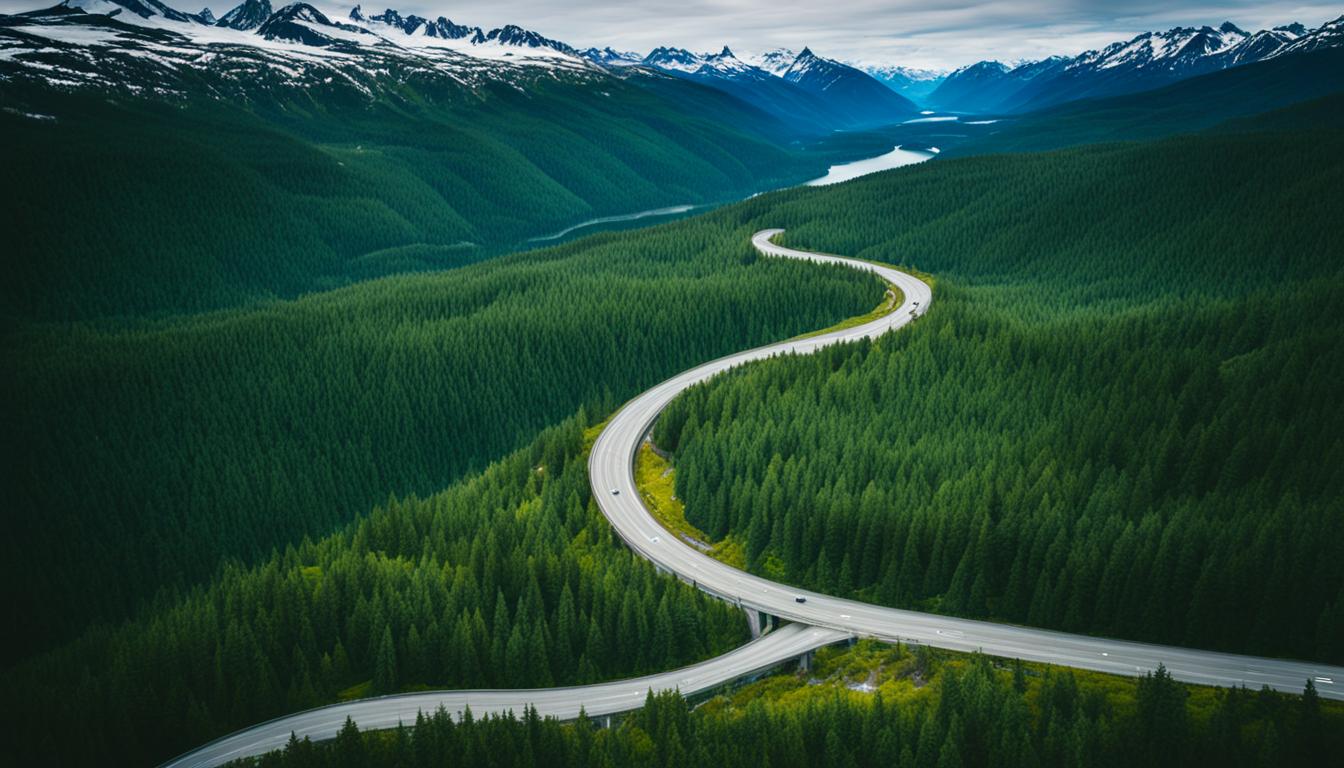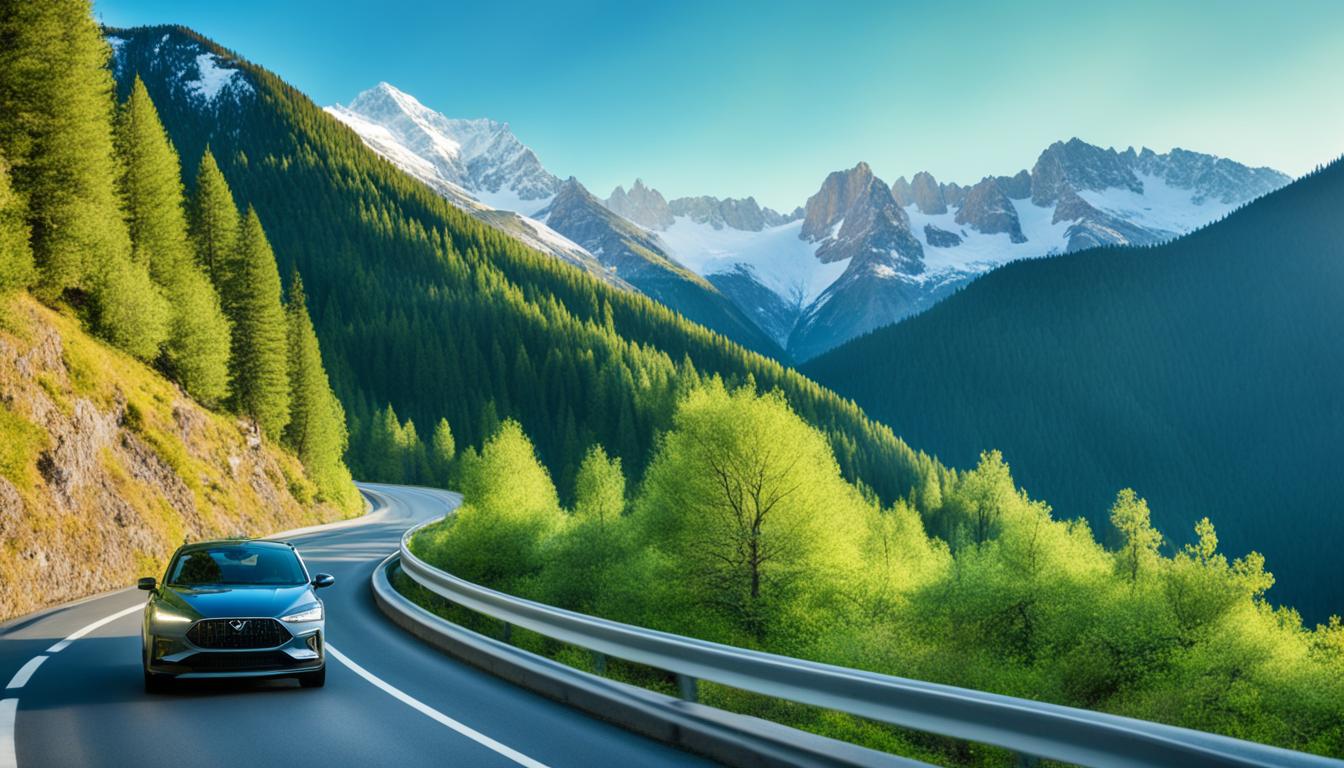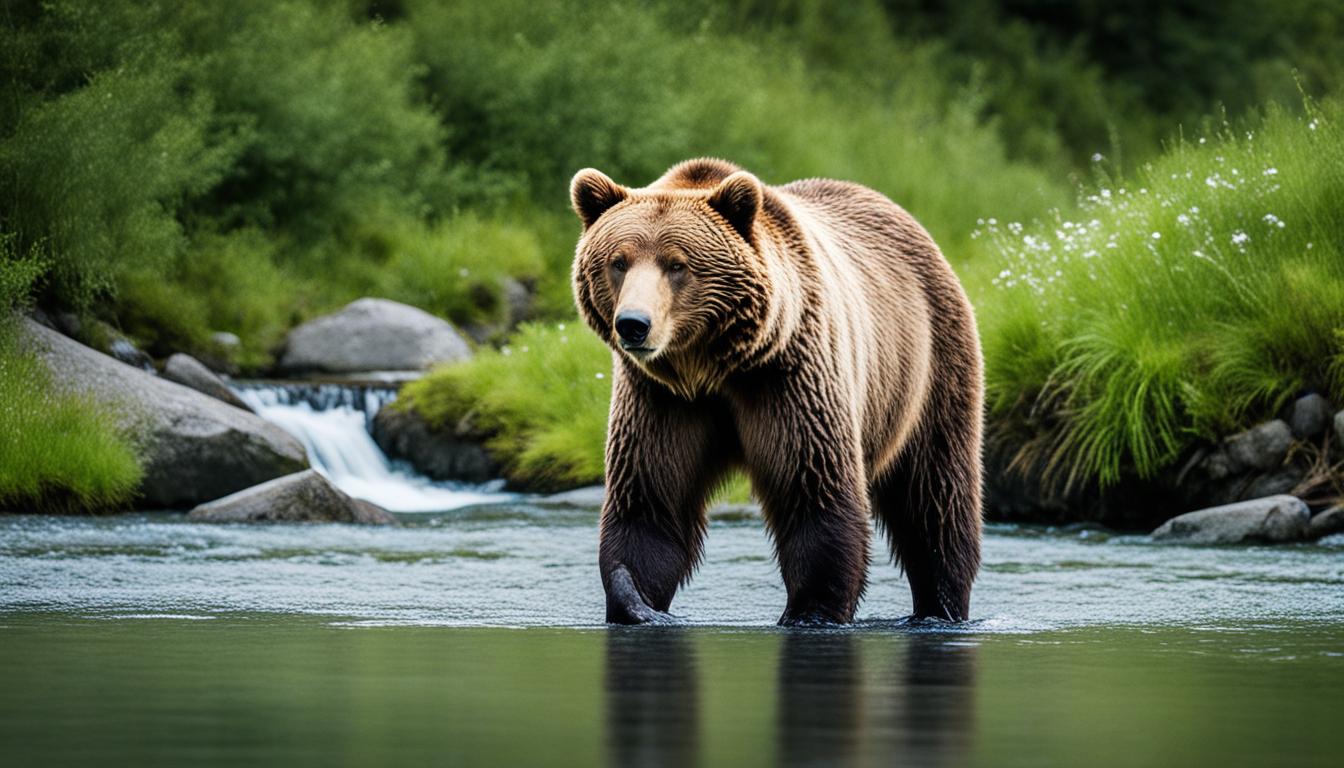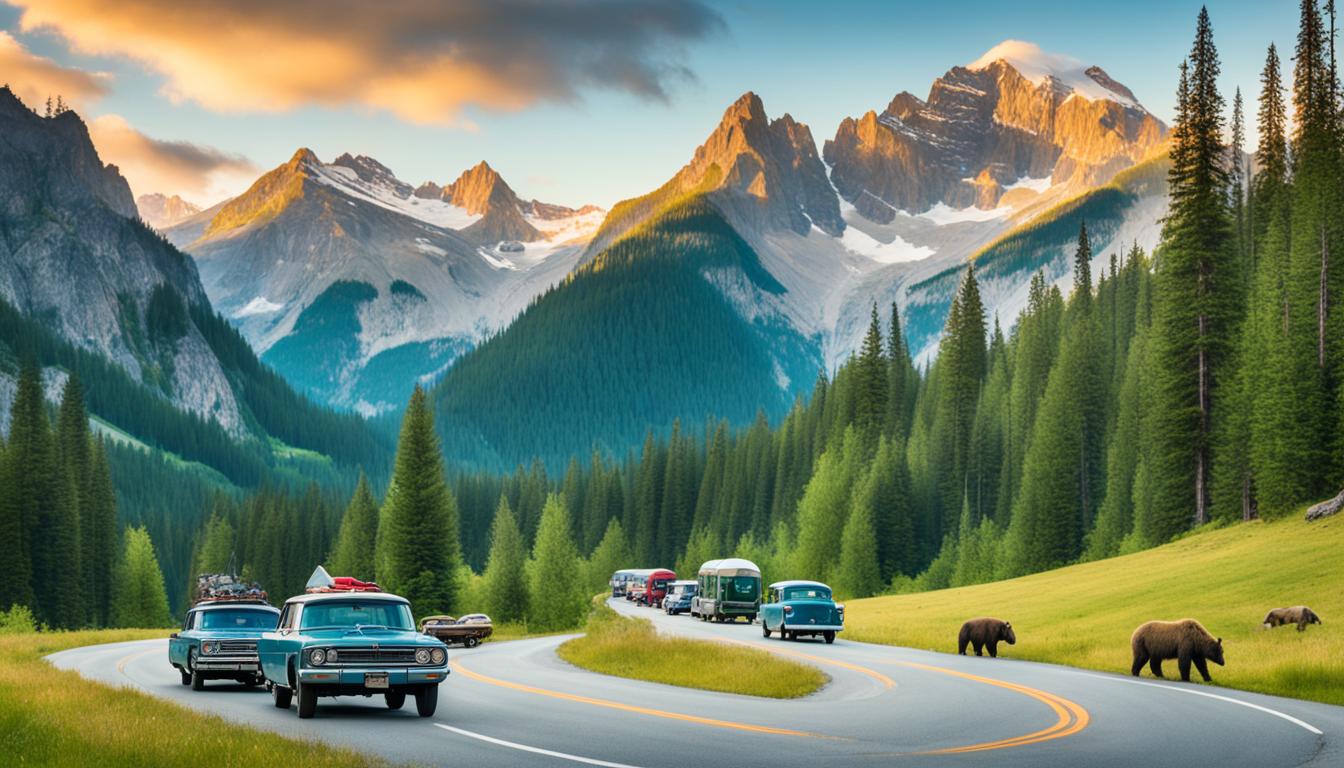Welcome!
Alaska Highway, British Columbia: Best Things to Do - Top Picks
Are you ready for an unforgettable road trip through British Columbia's stunning landscapes? The Alaska Highway, also known as the Alcan Highway, takes you from lush Canadian Rockies to the Yukon's rugged wilderness. This guide will show you the best spots to visit along the British Columbia part of this famous route. It ensures you enjoy your adventure to the fullest.
Key Takeaways
- The Alaska Highway stretches over 1,500 miles through British Columbia, the Yukon, and into Alaska.
- Explore scenic provincial and national parks, historic sites, and abundant wildlife viewing opportunities.
- Discover the rich cultural experiences and outdoor adventures that await along the route.
- Plan for at least a week to fully immerse yourself in the captivating sights and activities.
- Prepare for varying weather conditions and remote areas by packing essential supplies and equipment.
Introduction to the Alaska Highway
The Alaska Highway, also known as the Alcan Highway, is a remarkable feat of engineering. It has captivated travelers for decades. This iconic road was built during World War II. The main goal was to connect the lower 48 states to Alaska.
This was to provide a vital overland route for military supplies and personnel.
History and Construction
In 1942, after the attack on Pearl Harbor, the United States saw the need to secure Alaska's defenses. An agreement was made with Canada. The US would fund the construction and maintain the road during the war and for 6 months after.
Then, Canada would take over. This effort involved over 10,000 American soldiers and 16,000 Canadian and American civilians. They worked hard to finish the highway in just 8 months. They faced harsh weather and tough terrain.
Route Overview
The Alaska Highway stretches 2,232 km (1,387 miles) from Dawson Creek in British Columbia. It goes through the Yukon Territory and ends in Delta Junction, Alaska. There, it connects with the Richardson Highway to Fairbanks.
This route takes travelers through remote, scenic areas of Canada. It offers a chance to see smaller towns and cities. And it shows off unique attractions and stunning natural landscapes.
| Segment | Distance |
|---|---|
| Dawson Creek, BC to Delta Junction, AK | 2,232 km (1,387 miles) |
| Delta Junction, AK to Fairbanks, AK | 158 km (98 miles) |
| Total Distance | 2,390 km (1,485 miles) |
Originally built for military use, the Alaska Highway has become a popular tourist route. Over the years, the road has been improved. Now, it welcomes visitors who want to see the stunning landscapes and unique communities along the way.
Getting to the Alaska Highway
To get to the Alaska Highway in Dawson Creek, British Columbia, you have a few options. You can start from Vancouver or Calgary. The trip offers beautiful scenery and a chance to explore Western Canada's wild nature.
Routes from British Columbia
From Vancouver, the best way to Dawson Creek is via Highway 97 north. You can get there by the Sea-to-Sky Highway (Highway 99) or the Trans-Canada Highway (Highway 1). Both routes take about 13 hours to cover the 718 miles (1,155 km).
Another way is to go up Highway 5 from Vancouver through Kamloops. Then, cross into Alberta and back into British Columbia to reach Dawson Creek. This route is a bit longer, about 820 miles (1,320 km), and takes around 14 hours.
Routes from Alberta
If you're starting from Alberta, you can also get to the Alaska Highway. The best route is via the Trans-Canada Highway (Highway 1) to Banff National Park. Then, take the Icefields Parkway (Highway 93) through Jasper National Park, and back into British Columbia to Dawson Creek. This drive from Calgary takes about 10.5 hours and covers 660 miles (1,065 km) of beautiful mountains.

Choosing any route to the Alaska Highway means embarking on an adventure. You'll get to see the stunning beauty of Western Canada along the way.
Best Time to Drive the Alaska Highway
Driving the Alaska Highway is a dream for many. The best time to go is from May to September. This period has clear roads, perfect for a trip. Summer, from June to August, offers long days and mild weather, but it's busier.
Early September is great for a quiet drive. You miss the peak of mosquitoes and see beautiful fall colors. Always be ready for weather changes on the Alaska Highway.
"The Alaska Highway is a true adventure, full of breathtaking landscapes and wildlife encounters. Choosing the right time to embark on this journey can make all the difference in your experience."
Choosing between summer days or autumn colors is up to you. The best time to drive the Alaska Highway depends on what you like. With good planning and a sense of adventure, you'll make memories on this famous Canadian road.
Tips for Driving the Alaska Highway
Preparation and Supplies
Before you start your Alaska Highway trip, make sure your car is ready. You'll need a full-size spare tire for the long stretches without services. Also, pack an extra gas can for emergencies. Don't forget to bring clothes for different weather, like warm layers and bug repellent.
The Milepost guidebook is a must-have for planning your Alaska Highway trip. It gives you mile-by-mile details on where to stay, see, and navigate.
Road Conditions and Safety
The Alaska Highway is mostly well-kept, but watch out for seasonal and weather changes. Be ready for potholes, construction, and wildlife on the road. Summer brings clear roads, but watch out for rain that can make it slippery. In spring and fall, snow and ice are more common, so you'll need winter driving skills.
Driving safely means keeping an eye on your speed and knowing the road conditions. With the right prep and safety focus, your drive through British Columbia and beyond will be unforgettable.
| Tip | Importance |
|---|---|
| Carry a full-size spare tire | Remote stretches may lack services |
| Bring an extra gas can | Emergency preparedness |
| Pack appropriate clothing | Accommodate variable weather conditions |
| Use the Milepost guidebook | Comprehensive resource for planning |
| Maintain a safe speed | Adapt to changing road conditions |
| Stay informed on road conditions | Ensure a safe and enjoyable journey |

"The Alaska Highway is an unforgettable journey, but preparation and safety should always be the top priorities."
Scenic Stops and Attractions Along the Way
Traveling along the Alaska Highway, you'll see amazing natural scenes and historical spots. You'll find everything from beautiful parks to unique roadside stops. There's a lot to see and enjoy.
Provincial and National Parks
The Alaska Highway goes through some of British Columbia's most beautiful parks. These parks offer great places for outdoor fun and sightseeing. Some top spots include:
- Stone Mountain Provincial Park, with its jagged peaks and alpine meadows
- Liard River Hot Springs Provincial Park, home to a renowned natural hot spring
- Kluane National Park and Reserve in the Yukon, known for its glaciers, mountains, and abundant wildlife
These parks are perfect for hiking, seeing wildlife, and enjoying Canada's northern beauty.
Historical Sites and Landmarks
The Alaska Highway is also full of historical sites and landmarks. These places tell the story of the region's past. Don't miss these stops:
- The Alaska Highway House in Dawson Creek, which offers a museum about the highway's construction during World War II
- The Walter Wright Pioneer Village in Dawson Creek, showcasing the early settlement and development of communities along the highway
- The Fort Nelson Heritage Museum, featuring antique car collections and transportation-themed exhibits
- The Signpost Forest in Watson Lake, Yukon, a quirky roadside attraction with over 75,000 signs from around the world
These sites give you a peek into the Alaska Highway's history and culture.
"The Alaska Highway is a true journey through time, where natural beauty and historical significance go hand-in-hand." - Jane Doe, travel writer
Wildlife Viewing Opportunities
Traveling the Alaska Highway through British Columbia lets you see lots of wildlife in their natural settings. You'll see moose, caribou, bears, dall sheep, and many bird species along the 2,237 km (1,387 mi) route. Keep your eyes open for these amazing creatures.
The Muncho Lake Provincial Park is a top spot for wildlife viewing on the Alaska Highway. It's a beautiful place with grizzly bears, Stone's sheep, and woodland caribou. Kluane National Park and Reserve in the Yukon is also great for seeing Alaska Highway wildlife. You can see Dall sheep on the mountains there.
For a special wildlife moment, visit Fish Creek in Hyder, Alaska, near the British Columbia border. During salmon season, you might see grizzly bears catching fish. It's an unforgettable sight.
Always keep a safe distance from wildlife and follow the rules to enjoy your visit responsibly. With patience and a sharp eye, the Alaska Highway trip will be filled with amazing wildlife encounters.

"The greatest reward and luxury of travel is to be able to experience everyday things as if for the first time, to be in a position in which almost nothing is so familiar it is taken for granted."
- Bill Bryson
Hiking and Outdoor Adventures
The Alaska Highway takes you through British Columbia's stunning wilderness. It offers many hiking options for those who love the outdoors. From day hikes to long backcountry treks, there's something for everyone.
Popular Hiking Trails
The Sulphur Skyline in Muncho Lake Provincial Park is a top spot for hikers. This trail is tough but gives amazing views of turquoise lakes and high peaks. In Kluane National Park, trails like the Slims River Trail and Icefield Discovery Trail let you see glaciers, meadows, and Dall sheep.
For a real challenge, try the Canol Heritage Trail in the Mackenzie Mountains. It's a long hike through untouched nature.
Camping and RV Parks
There are many campsites and RV parks along the Alaska Highway. They suit different needs, with amenities like hookups, showers, and laundry. It's smart to book sites early in the summer.
If camping isn't your thing, there are motels, lodges, and other places to stay in towns and cities. But book these early too.
| Hiking Trail | Location | Difficulty | Distance |
|---|---|---|---|
| Sulphur Skyline | Muncho Lake Provincial Park | Challenging | 8 km return |
| Slims River Trail | Kluane National Park | Moderate | 12 km return |
| Icefield Discovery Trail | Kluane National Park | Moderate | 14 km return |
| Canol Heritage Trail | Mackenzie Mountains | Difficult | Multi-day backcountry |
"The Alaska Highway is a gateway to some of Canada's most breathtaking wilderness, offering a wealth of hiking opportunities for adventurous travellers."
Alaska Highway, British Columbia: Best Things to Do - Top Picks
The British Columbia part of the Alaska Highway is full of natural beauty, outdoor fun, and historical sites. It's a place every traveler should see. You'll find peaceful lakes, hot springs, stunning mountains, and wildlife.
Muncho Lake and Muncho Lake Provincial Park are highlights of the Alaska Highway in British Columbia. This beautiful lake is in the Rocky Mountains. It's perfect for hiking and enjoying the calm nature.
Don't miss the Liard River Hot Springs. Here, you can relax in warm, mineral-rich waters. It's a great way to relax after exploring the Alaska Highway.
The Sulphur Skyline trail is great for those who love a challenge. It offers amazing views of the mountains. The hike is a bit tough but worth it for the stunning views.
History fans should visit the Alaska Highway House in Dawson Creek. It tells the story of building the highway during World War II. It's a fascinating look at the engineering feat that linked British Columbia and Alaska.
The Alaska Highway in British Columbia is also great for seeing wildlife. You might spot moose, caribou, or bears. Plus, you can learn about the local culture, making your trip memorable.
"Exploring the Alaska Highway in British Columbia is like embarking on a grand adventure, where natural wonders, outdoor thrills, and captivating history come together to create a truly unforgettable journey."

Cultural Experiences and Local Communities
Driving the Alaska Highway in British Columbia and the Yukon lets you dive into the rich culture and lively communities of northern Canada. You'll see indigenous art and traditions and meet friendly locals. These experiences show you the unique spirit of the area.
In Whitehorse, the Yukon's capital, you can check out cultural spots that highlight local First Nations art, crafts, and customs. See the beautiful totem poles and learn what they mean. Then, head to Watson Lake and see the Signpost Forest, where travelers have left signs and memories for years.
Smaller towns along the way give you a peek into local life. Stop by shops, cafes, and community spots to meet the locals. They'll share stories about the area's history and traditions. These moments make your trip more meaningful and show the diversity and strength of the people living here.
"The Alaska Highway is not just a road, but a living, breathing tapestry of cultures that have shaped this remarkable region. Embracing the local communities and their traditions is an integral part of the true highway experience."
Exploring indigenous art, visiting historical sites, or just talking with locals makes your trip special. These cultural experiences bring depth and richness to your journey through British Columbia and the Yukon's beautiful landscapes.
Conclusion
Starting an Alaska Highway road trip through British Columbia is an adventure you won't forget. It offers stunning landscapes, rich culture, and lots of outdoor fun. You'll see the wild beauty of parks and meet friendly people in small towns.
This highway is perfect for anyone who loves nature, animals, or history. It gives you an epic drive that you'll always remember. With good planning and preparation, you'll find amazing spots and stories along the way.
So, if you're up for an amazing trip, pack your bags and hit the road. You'll find natural beauty, cultural treasures, and outdoor adventures on the Alaska Highway in British Columbia. Get ready for a journey you'll always look back on fondly.
FAQ
What is the Alaska Highway and where does it run?
The Alaska Highway, also known as the Alcan Highway, stretches 2,232 km (1,387 miles). It goes from Dawson Creek in British Columbia, through the Yukon, and ends in Delta Junction, Alaska.
When was the Alaska Highway built and why?
Built in 1942 for World War II, the Alaska Highway connects the lower 48 states to Alaska. After Pearl Harbor, the US wanted a land route to Alaska for defense.
What are some of the top attractions and highlights along the British Columbia portion of the Alaska Highway?
Top spots include Stone Mountain Provincial Park and Liard River Hot Springs Provincial Park. Kluane National Park and Reserve, the Alaska Highway House in Dawson Creek, and the Signpost Forest in Watson Lake are also highlights. There's also wildlife viewing and hiking.
What is the best time of year to drive the Alaska Highway?
The best time is May to September, when roads are clear. June to August has long daylight and mild weather. Early September is great for avoiding mosquitoes and seeing fall foliage.
What should travellers do to prepare for driving the Alaska Highway?
Make sure your vehicle is reliable with a full-size spare tire and an extra gas can. Wear warm and mosquito-repellent clothing. The Milepost guidebook is key for planning and finding places to stay.
What kind of wildlife can be seen along the Alaska Highway?
You might see moose, caribou, bears, dall sheep, and various birds. Muncho Lake Provincial Park, Kluane National Park, and the Fish Creek area in Hyder, Alaska, are great for wildlife watching.
What kind of outdoor activities and hiking opportunities are available along the Alaska Highway?
There's plenty of hiking, like at Sulphur Skyline in Muncho Lake Provincial Park. The Slims River Trail and Icefield Discovery Trail in Kluane National Park are also great. Camping and RV spots are easy to find along the way.
Related Posts
By accepting you will be accessing a service provided by a third-party external to https://travel.com/